
Functions may act on arrays. For example,
Reccall that arrays can be represented as vectors. If u = (x,y) and v = (α,β) then
Let v represent an array. Then
[1.1] (Linear transformation) A linear transformation L on a vector space of arrays all of the same length is a function satisfying the following two conditions:
(a) L(u + v) = L(u) + L(v)
(b) L(λv) = λL(v)
where u and v are vectors (arrays) and λ is any real number.
In most discussions, the lengths of arrays will be 2 or 3, but in most discussions the facts will apply to longer arrays as well. The term vector space will mean the collection of all arrays of length 2, or the collection of all arrays of length 3.
Not discussed are linear transformations between vector spaces of arrays of different lengths, for example, linear transformations from the collection of arrays of length 3 to the collection of arrays of length 2.
The abbreviation lintr will mean "linear transformation". Also the letter L will be used exclusively for lintr. If there are more than one lintr in a discussion, then subscripts will be used: L1, L2, L3,... .
Recall that the zero vector 0 is an array of zero coordinates: 0 = (0,0) or 0 = (0,0,0).
The following states a necessary condition that a function be a lintr:
[1.2] (All Linear transformations leave the zero vector fixed) Every linear transformation carries the zero vector back onto itself.
Notation: L(0) = 0
Part (b) of [1.1] provides a simple proof. Set λ = 0.
What makes any lintr useful is its effect on lincombs (linear combinations) of vectors:
[1.3] (Linear transformations of linear combinations) A linear transformation carries a linear combination of vectors onto a linear combination of images of those vectors but with the same coefficients.
Notation: L(αa + βb + γc + δd + ...) =
αL(a) + βL(b) + γL(c) + δL(d) + ...
This statement is actually an application of definition [1.1] many times to the terms of the lincomb.
Recall that the orthonormal arrays (1,0), (0,1) and (1,0,0), (0,1,0), (0,0,1) are special arrays, because for any arbitrary arrays (x,y) and (x,y,z) the letters may be "factored out" of the arrays leaving the special arrays with the letters as coefficients:
If images L(1,0) and L(0,1) are known, then the image L(x,y) can be computed. For example, if
[1.4a] (Images of special arrays) A linear transformation is completely determined by the images of the special arrays.
Notation: if images L(1,0) and L(0,1) are known, then L(x,y) can be computed from xL(1,0) + yL(0,1)
If images L(1,0,0), L(0,1,0) and L(0,0,1) are known,
then L(x,y,z) can be computed from xL(1,0,0) + yL(0,1,0) + zL(0,0,1).
[1.4b] (Images of special arrays)
If L(1,0) = (α1, α2) and L(0,1) = (β1, β2) then
Click here to see the computations supporting these equalities.
The reader can verify that if
Expressions like 2x + 4y - 2z, x + 5y + 7z, 4x + 6y + 8z occur often as coordinates.
An expression αx + βy is called a linear expression in x and y. An expression αx + βy + γz is called a linear expression in x,y and z. Notice that a linear expression has no vectors, just real numbers and variables x,y and possibly z. And every term has x,y or z in it. Linear expressions are used to determine linear transformations expressed in terms of coordinates.
[1.5] (Linear transformations and linear expressions)
If L(x,y) = (linear expression in x and y, linear expression in x and y) then L is a linear transformation on arrays of length 2.
If L(x,y,z) = (linear expression in x,y and z, linear expression in x,y and z, linear expression in x,y and z) then L is a linear transformation on arrays of length 3.
For example,
Through the use of images of special arrays, there is a close association between linear transformations and matrices:
[1.6] (Associated matrices) For any linear transformation, its images of the special arrays become columns in the associated matrix.
Notation:
(a) if L(1,0) = (α1, α2) and L(0,1) = (β1, β2) then the following matrix M is associated with L:

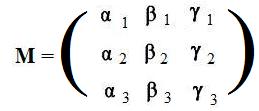
The matrices contain all of the coordinates of the images of the special arrays. However, the when linear transformations are involved, the arrays are written horizontally and separately: for 2x2 arrays, (α1, α2) and (β1, β2); for 3x3 arrays (α1, α2, α3), (β1, β2, β3) and (γ1, γ2, γ3). But in the matrices the images are written in columns: for 2x2 arrays: (α1, α2)t and (β1, β2)t; for 3x3 arrays, (α1, α2, α3)t, (β1, β2, β3)t and (γ1, γ2, γ3)t, where ( )t is the transpose of ( ).
Iintuitively speaking, the row of αs become the (first) column of αs, the row of βs become the (second) column of βs, and if present the row of γs becomes the (third) column of γs.
GIven a linear transformation defined by L(x,y) or L(x,y,z), the associated matrix is easily found. For example, what is the matrix associated with the linear transformation L defined by L(x,y) = (5x + 6y, 8x + 7y) ?
First needed are the images of the special arrays. L(1,0) = (5,8) [set x=1, y=0], L(0,1) = (6,7) [set x=0, y=1]. The columns of the matrix M associated with L are (5,8)t and (6,7)t. Therefore the matrix is:
Given the matrix M, is it possible to produce the lintr L, or more exactly, produce L(x,y) ? The answer is yes. But it must be remembered that with M vertical arrays are used, while with L, horizontal arrays are used.

[1.7] Let M be the matrix associated with a linear transformation L.
(a) For the vector space of 2x2 arrays, M(x,y)t = L(x,y)t
(b) For the vector space of 3x3 arrays, M(x,y,z)t = L(x,y,z)t
From [1.7] it may be said that the matrix of a lintr has enough of the essential information of the lintr. Since the associated matrix of a lintr on a vector space is square (2x2 or 3x3) it is possible to give meaning to the phrase the determinant of a linear transformation. The determinant of a linear transformation on a vector space is the determinant of the associated matrix.
Recall that it is sometimes possible to combine two functions called their product. If L1 and L2 are linear transformations, then it is possible to form their product L2L1. If L1 carries u onto v and L2 carries v onto w then L2L1 carries u onto w.
Notation: L2L1(u) = L2(v) = w
Notice that the product is written in the reverse order of their execution: in L2L1 the lintr L1 acts before L2 acts.
[1.8] (Products of linear transformations) The product of two linear transformations (on the same vector space) is again a linear transformation (on that vector space).
Notation: L1 and L2 are linear transformations, then L2L1 is a linear transformation.
Click here to see an argument supporting this statement.
[1.9] (Products of linear transformations and their associated matrices) The matrix associated with the product (composition) of two linear transformations (on the same vector space) is equal to the product of the matrices associated with those linear transformations, taken in the same order.
Notation: If M1 and M2 are the matrices associated with the linear transformations L1 and L2, then the product M2M1 is the matrix associated with the product L2L1.
Click
This theorem [[1.9] can be used to find a simple way for computing the product of two linear transformations: shift the work to computing the product of their associated matrices.
The identity functions I2 and I3 on arrays of lengths 2 and 3 respectively carries each array back onto itself (leaves every array fixed):
For any lintr L, LI = L and IL = L. Similar statements may be said about the matrix M associated with L.
[1.10] (Inverse of a linear transformation) Let L be a linear transformation on a vector space. If det L is not zero, then an inverse linear transformation L-1 exists. The matrix associated with L-1 is the inverse of the matrix associated with L.
Recall that by definition det L = det M where M is the matrix associated with L. Therefore the hypothesis det L is not zero means that M has an inverse. From the inverse of M a linear transformation L* can be constructed. Since MM-1 = I the product LL* = I. . This makes L* the inverse of L, that is L* = L-1.
[1.11] A linear transformation on a vector space of arrays is called singular if its determinant is zero. A linear transformation on a vector space of arrays is
Let L be a lintr. Quite often the symbol A', B', C', P', Q', R' are symbols used to denote is the image of points A, B. C, P, Q, R:
Example: Suppose L is defined by L(x,y) = (2x + 3y, 4x + 5y). If P(6,5) then P'(27,49) because L carries array (6,5) onto array (27,49). For this example, x' = 2x + 3y and y' = 4x + 5y.
When the term "image" is used it means that some lintr is involved to produce that image.
[2.1] (The origin left fixed) Every linear transformation must carry the origin back onto itself.
This is a direct result of the fact that a lintr carries the array 0 of all zeros back onto itself. Depending upon the lintr there may or may not be other points carried onto the origin.
If P' is the image of point P then the images of O and P are O and P', that is, L(OP) = OP'. This says that position vector p is carried onto position vector p': L(p) = p'.
[2.2] (Images of position vectors) A linear transformation carries a position vector locating a point onto a position vector locating the image of that point.
Recall that collinear points lie on a common line. The use of position vectors provides simple argument for the following fact:
[2.3] (Linear transformations preserve collinearity) Every linear transformation carries collinear points onto collinear points.
IF A and B coincide, then L(A) and L(B) coincide and [2.3] is trivial. Suppose A and B are distinct. Using Notation2, AP = λAB for some real number λ. This leads to the equation involving position vectors:
By [2.3] all linear transformations carry collinear points onto collinear points. But what happens if the points are not collinear? If points A,B,C are not collinear, what about their images L(A), L(B), L(C) ?
[2.4] (Images of points which are not collinear) A non-singular linear transformation carries non-collinear points onto non-collinear points.
Click here to see the proof of this statement.
[2.5] (images of segment) A linear transformation carries an entire segment onto a segment or onto a point.
Click here to see the proof of this statement. Statements [2.4] and [2.5] imply that a non-singular lintr carries a genuine triangle onto a genuine triangle, more generally a polygon onto a polygon. This gives lintr a geometric character.
[2.6] (Image of line) A linear transformation carries an entire line onto an entire line or onto a point..
Click here to see discussion supporting this statement.
[2.7] (Images of the plane) [sp3] A linear transformation on the plane does one of the following:
The rank number assigned to the lintr is actually the dimension of image of the plane. Planes, lines, points have dimensions 2, 1, 0 respectively. Also they are the the ranks of the 2x2 matrices associated with the transformation.
There is only one lintr of rank 0 ([2.7c]). It is considered trivial and not interesting. Squashing the entire plane into a single point removes anything interesting. Discussions below involve mostly non-trivial lintrs. On the plane, only lintrs of rank 2 ([2.7a]) are non-singular. Intuitively speaking, only they can preserve recognizable shapes of geometric figures such as parallelograms and triangles (however they may be resized and/or sheared). A lintr of rank 1 will send any geometric figure into a line (through the origin) and flaten it inside the line. Transformations of rank 1 and rank 0 are singular, and never have inverses. Intuitively speaking, their effects on the plane cannot be undone by some reverse transformation.
Let L be any lintr on the plane. Then L can do one of three things with a point P:
Part (a) leads to the idea of kernels discussed in section 6.
Suppose A, B, C, D are four points satisfying the vector equation
[2.8] (Preserving proportionality) If one vector is λ times a second vector, then for any linear transformation, the image of the first vector is λ times the image of the second vector, where λ is any real number.
Note: [2.8] does not imply that vectors AB and its image A'B' are equal, have the same length or are even being parallel. The lintr may carry a horizontal or vertical figures onto images at any slant or angle.
[2.9] (Preserving parallelism and proportionality) For any linear transformation,
To simplify the wording of [2.9b] allow a line to be parallel to itself. This allows singular lintrs to have the property described in [2.9b]. This convention also makes the relation "is parallel to" an equivalence relation between lines.
[2.10] (preserving parallelograms and trapezoids) For any non-singular linear transformation,
Click here to see more discussion of lintrs preserving parallelograms and trapezoids. However, there exist some lintrs that do not preserve squares, rectangles or isosceles trapezoids.
For example, suppose a linear transformation L carries the special points onto the origin.
This proves the following:
[2.11] (Rank 0) A linear transformation carries every point in the plane onto the origin if and only if it carries the special points onto the origin.
The lintr in [2.11] is trivial. It is often called the
Similarly, using L(1,0) = (1,0) and L(0,1) = (0,1) it is easy to show L(x,y) = (x,y). Therefore,
[2.12] (Leaving points fixed) A linear transformation leaves every point fixed (it is the identity transformation) if and only if it leaves the special points fixed.
The following says that if a lintr carries the special points onto a line (the line must pass through the origin because O is always an image) then the lintr carries the entire plane onto that line.
[2.13] (Rank 1) A linear transformation is not the zero transformation and carries every point onto a line through the origin if and only if the images of the special points are not both zero and both lie on a line through the origin.
Click here for a short proof of this statement.
Using the identity L(x,y) = xL(1,0) + yL(0,1) the reader can easily show that if the lintr carries the special point (1,0) onto the origin then the lintr carries the plane onto the y-axis: L(x,y) = (0,y). Similarly, if it carries the point (0,1) onto the origin then the plane is carried onto the x-axis: L(x,y) = (x,0), Not both images are the origin.
[2.14] (Rank2) A linear transformation carries the entire plane back onto itself if and only if the images of the special points are not both on the same line (through the origin)..
Click here for a proof of this statement.
The linear transformation in [2.14] is non-singular.
The special triangle is a genuine triangle - its vertices are non-collinear points. Is its image a genuine triangle?
Sometimes statements are made better by using the special triangle.
The special triangle has four important properties:
Oriientations will involve only linear transformations of rank 2 (non-singular).
Lying along the congruent sides of the special triangle are special vectors:
Intuitively speaking, what a linear transformation does to the special points determines what it does to the special triangle, and conversely. In particular, some linear transformations carry geometric figures onto congruent figures. The most simple siguation involves segments. A linear transformation that carries all segments onto congruent segments is said to preserve distance. The following is a more direct definition:
[2.15] (Preserving distance) A linear transformation L preserves distance if and only if the distance between any pair of points is equal to the distance between their images.
Although the name is not generally used, a distance preserving transformation might be called a "congruence linear transformation." However, in this chapter on linear transformations, the phrases a "linear transformation that preserves distance" or "distance preserving linear transformation"will be used. (For readers who have heard the term "isometry", it will be introduced in the next chapter on affine transformations.)
Example 1
Using absolute value notation and coordinates, L,, defined by L(x,y) = some formula in x and y, preserves distance if and only if
Example 2
The proof of [2.15] and Example 2 could be shortened by using the following:
[2.16] (Preserving norms) A linear transformation preserves distance if and only if it carries every position vector onto a position vector of equal length.
Assume that L preserves distance. To prove that it carries position vectors onto position vectors of equal lengths.
Assume that L preserves norms of all position vectors. To prove that L preserves distance.
The following provides another condition that a lintr preserves distance.
[2.17] (Preserving distance) A linear transformation preseerves distance if and only if it carries the special triangle onto a congruent triangle.
Assume L preserves distance. To prove the triangles are congruent.
Assume that the triangles are congruent. To prove L preserves distance
[2.18] (Corollary: preserving congruence of triangles) A linear transformation carries every triangle onto a congruent triangle if and only if it carries the special triangle onto a congruent triangle.
Assume that lintr carries every triangle onto a congruent triangle. Then it carries, in particular, the special triangle onto a congruent triangle.
Assume the lintr L carries the special triangle onto a congruent triangle. To prove that L carries every triangle onto a congruent triangle.
The truth of the following two statements will be assumed.
[2.19a] (Preserving orientation) A distance preserving linear transformation carries a simply closed polygon or circle onto a closed polygon or circle of the same orientation if and only if it carries the special triangle onto a triangle with the same orientation.
[2.19b] (Reversing orientation) A distance preserving linear transformation carries a simply closed polygon or circle onto a closed polygon or circle of the opposite orientation if and only if it carries the special triangle onto a triangle of opposite orientation.
The first and second actions [3.1] and [3.2] introduce these ideas.
[3.1a] (Reflection through the origin) The origin is the midpoint of the segment joining any point and its reflection through the origin.
[3.1b] Some immediate results of [3.1a]:
[3.1c] (Images of the special points and triangle)
It is obvious that O is the mid point of the segment joining (1,0) and (-1,0)
[3.1d] (The reflection through the origin is a linear transformation) The linear transformation L defined by
Since the images of (1,0) and (0,1) are (-1,0) and (0,-1) respectively, L(1,0) = (-1,0) and L(0,1) = (0,-1).
The equation for L(x,y) is derived from L(x,y) = xL(1,0) + yL(0,1) = x(-1,0) + y(0,-1) = (-x,-y).
More generally, any positive real number λ can be used in place of 2:
[3.2a] (Similitude) The action of obtaining a point P' from an arbitrary point P by the vector equation (*) is called a similitude with center at the origin and with coefficient λ, a positive real number..
[3.2b] For various values of λ the geometric effects are:
A similitude is completely determined by its coefficient. In fact the collection of all similitudes is in one-to-one correspondence with all the positive real numbers. That collection of similitudes is actually a group.
[3.2c] (Images of the special points) A similitude with coefficient λ carries the points (1,0) and (0,1) onto the points (&lambda, 0) and (0,λ) respectively.
If E1 and E2 are the special points (1,0) and (0,1) spectively, and E'1 and E'2 are the images by action of the similitude, then (position vectors)
From the transposes of the images of the special points the following matrix is formed:
[3.2d] (A similitude with center at the origin is a linear transformation) The linear transformation L defined by
Let P(x,y) and P'(λx,λy). Since (λx,λy) = λ(x,y), OP' = λOP. Therefore, L is a similitude with coefficient λ.
[3.2e] (Parallel image) A similitude carries segments onto parallel segments.
Vectors OP' = λOP and OQ' = λOQ. Converting these vectors to position vectors
[3.2f] (Preserving angles) A similitude carries intersecting lines onto intersecting lines in such a way that the angle of intersection of the second pair of lines is congruent to the angle of intersection of the first pair.
By [[3.2e] segment A'B' and B'C' are parallel to AB and BC respectively. Therefore angle A'B'C' is congruent to angle ABC.
However, similitudes do not preserve lengths of segments. The images of segments are not necessarily congruent to the segments.
Upon comparison of the two triangles, two observations can be made.
In both examples it is the action of producing the copies that is the focus of these discussions. First is a geometric description of the action that reflects the triangle about the vertical line (Fig 1b). If a horizontal line segment is drawn joining points A and A' (vertices of the triangles) then the vertical line is the perpendicular bisector of segment AA'. Similarly, it is the perpendicular bisector of horizontal segments BB' and CC'. In general, if P is any point, then its image P' determines a horizontal segment PP' of which the vertical line is a perpendicular bisector.
Now to derive the formula for the linear transformation that does the reflecting of the triangle. The lintr requires the environment of the coordinate plane where each point has a label, an array of length 2. Place the original right triangle in the first quadrant of the coordinate plane and the vertical line on the y-axis. Since the vertices are points, they have attached labels, say
[3.3a] (Orthogonal reflection L about the y-axis)
The algebraic definition makes L a linear transformation, since the expressions inside (-x,y) are linear expressions.
The derivation of the formula for the lintr that reflections the parallelogram about the horizontal line (Fig 2) is obtained in a similar way. But in this case the horizontal line is the perpendicular bisector of vertical segments AA', BB', CC' DD'. Place the original parallelogram in the first quadrant of the coordinate plane and the horizontal line on the x-axis.
[3.3b] (Orthogonal reflection L about the x-axis)
The algebraic definition makes L a linear transformation, since the expressions inside (x,-y) are linear expressions.
The reflections about the xaxis and the y-axis are linear transformations. Therefore, they have associated matrices. These matrices are obtained from what happens to the special points (1,0) and (0,1). The reflection about the y-axis carries these points onto (-1,0) and (0,1) respectively. Then the transposes of these images become the columns in the associated matrix.
The reflection about the x-axis carries the special points (1,0) and (0,1) onto (1,0) and (0,-1) respectively. Then the transposes of these images become the columns in the associated matrix.
[3.3c] (Associated matrices for the orthogonal reflections about the axes:
Any orthogonal reflection about a line through the origin must reflect the special points (1,0) and (0,1) about that line. In [3.3d] and [3.3e] that follow assume that the line passes through the origin and has an inclination angle θ.
[3.3d] (Reflected images of the special points) A reflection about the line with inclination angle θ carries (1,0) and (0,1) onto the points
Click here to see a discussion supporting this statement.
[3.3e] (Reflection is a linear transformation) The linear transformation L defined by
Click here to see a discussion supporting this statement.
Statements [3.3d] and [3.3e] combine to support the following:
[3.3f] (Orthogonal reflection about any line through the origin)
The associated matrix comes directly from [3.3d].
If θ = 90° then lineo is the y-axis. The associated matrix (6) becomes the first matrix in (3) above.
A precise geometric definition of a rotation is not given here. It would not be in the spirit of an intuitive introduction to rotations. Instead two equivalent intuitive descriptions [3.4a] and [3.4b] are given below.
Suppose this plane is empty. Then each point P in the fixed plane is copied vertically into the movable plane above it to make a point P. After all the points have been copied from the fixed plane, the movable plane is rotated through a given angle. If the angle is positive then the rotation is done counter-clockwise. If the angle is negative then the rotation is clockwise. Each point P is carried along with the rotating movement. After the rotation of the movable plane is completed, then P is above some point P' in the fixed plane. (The new position of the movable plane and point P' are not shown in the figure.)
The rotation function on the fixed plane carries P onto P'.
The above description places the two parallel planes in three dimentional space. The following is an equivalent description of the rotation function in the two dimentional (fixed) plane, and does not involve any rotating (green) plane. But it does involve an arbitrary point P in the (fixed) plane to be carried onto a point P' in that same plane. It is this description that will lead to a more rigorous algebraic definition of a rotation.
[3.4c] There are several immediate results from this description:
The proof of the following important statement is almost trivial:
[3.4d] (Combining rotations) If a pair of rotations act on a plane, then the angle of the combined rotations (one acting after the other) is equal to the sum of the angles of the individual rotations.
The first rotation carries point P onto point P', and the second rotation carries point P' onto P".
The angles involved with rotations are real numbers, which are commutative. This makes the combinedaction of any two rotations commutative - either rotation may act first.
[3.4e] The collection of all rotations about the origin form a commutative group.
It is time now to derive the formula for a rotation. First the images of the special points (1,0) and (0,1) are calculated.
[3.4f] (Rotated images of the special points) A rotation through angle θ carries points (1,0) and (0,1) onto the points
Click here to see the discussion supporting this statement.
[3.4g] (General formula for rotation) The linear ttransformation L defined by
Click here to see the discussion supporting this statement.
[3.5a] (Geometric description) Where the line through the given point intersects the given line perpendicularly is the point called the orthogonal projection of the given point upon the given line. (If the given point is already on the given line then the point is also the orthogonal projection upon the given line.) Do this action for every point in the plane.
Clearly the line segment joining the given point and its projected image is perpendicular to the given line.
[3.5b] Some obvious results of [3.5a]
(i) The location and position of a given line completely determine the orthogonal projection of the entire plane onto it.
The vertical projection onto the x-axis of the special points (1,0) and (0,1) is (1,0) = (1,0) (point is already on the x-axis) (0,1) ---> (0,0), (point (0,1) is above the origin). Also the horizontal projection onto the y-axis of (1,0) and (0,1) produces images (0,0) and (0,1).
>b>[3.5c] (Images of the special points) The images of (1,0) and (0,1) projected orthogonally onto the x-axis and y-axis are (1,0), (0,0) and (0,0), (0,1) respectively.
The matrices from the transposes of these images are:
[3.5d] (Formula for projection onto the axes) The linear ttransformations L1 and L2 defined by
Click here to see an argument supporting this statement.
From the transposes of the images of the special points the following matrix is obtained:
Click here to see an argument supporting this statement.
The most simple of congruent figures are segments. For two segments to coincide it is sufficient that their end points coincide. For a linear transformation L to carry a segment AB onto a congruent segment CD it is sufficient that L(A) = C and L(B) = D. In other words, the distance between points A and B is the same as the distance between points L(A) and L(B).
[5.1] (Preserving distance) A linear transformation preserves distance if and only if for every pair of points the distance between the points is equal to the distance between their images.
Another name for a distance preserving linear transformation is a linear isometry. (There are other kinds of isometries. A translation is an isometry which is not a linear translation.) Two figures are congruent if there is an isometry that carries one figure onto the other. Therefore, an isometry may also be called a "congruence transformation" but this name is seldom used.
The linear transformation carries vectors onto vectors. A linear transformation that preserves distance carries vectors onto vectors of equal lengths (norms). This is true of position vectors. If L is a linear transformation that preserves distance, then |L(p| = |p| because distance between O and P = distance between O and L(P).
From their introductory intuitive descriptions given in the previous section, it seems obvious that rotations and orthogonal reflections about lines are distance preserving transformations. These facts can be proven by elementary geometry. In the previous section the actions first affected the special points, then extended to all of the plane. That method can be used here. Intuitively speaking, if a linear transformation preserves distance at the origin, then it preserves distance everywhere. Let E1 and E2 be the names of the special points (1,0) and (0,1) respectively that is,
Then
This information is more easily stated in terms of the special vectors i and j. They are position vectors that locate the special points (1,0) and (0,1):
[5.2] A linear transformation preserves distance if and only if it carries the special vectors onto orthonormal position vectors.
Let P be the point with coordinates (x,y). Then position vector p = OP. To show that |L(p)| = |p|.
Since p = (x,y) = x(1,0) + y(0,1) then L(p) = xL(1,0) + yL(0,1).
By the distance formula, |r|2 = x x2 + y2
[3.1] Action: Reflection of the entire plane through the origin onto that entire plane
The rest of this chapter will make heavy use of angles and trigonometric functions. Click here to review some of them.
Intuitive idea:
Each point P in the fixed plane is copied vertically into the plane above it to make a point P. After all the points have been copied from the plane, the plane is rotated through a given angle. Each point P is carried along with the rotating movement. After the rotation of the green plane is completed, then P is above some point P' in the fixed plane. (The new position of the green plane and point P' are not shown in the figure.)
The rotation function on the fixed plane carries P onto P'.
The orientation requirement distinguishes rotations from another function discussed in [3.3] below.
Let P be any point (except the origin O) and let L be a rotation about the origin. Let θ be the angle of rotation. The initial side of θ passes through P and the terminal side of θ passes through P' = L(P). And |OP| = |OP'| from the definition. The triangle OPP' has the same orientation as θ: both are counter-clockwise (upper figure) or both are clockwise (lower figure).
[3.2a] The signed angle and origin completely determine a rotation.
[3.2b] A rotation about the origin through an angle of zero is equal to the identity function.
If θ = 0 then P' = P. SInce P is any point, this means that the rotation leaves every point fixed. This, in turn, means that the rotation is equal to the identity function: L = I
[3.2c] A rotation about the origin through an angle of 1/2 rev (180°). is equal to the reflection through the origin (see [3.1] above).
The initial and terminal sides of an angle of measurement 1/2 rev form a full straight line. The origin is always the mid point of the segment joining any point and its image. But this is the definition of the reflection of points through the origin.
[3.2d] Rotations about the origin preserve distance.
Click here to see a proof of this statement.
[3.2e] Rotations about the origin are linear transformations.
This follows from [3.2d] and [2.2].
[3.2f] Rotations about the origin preserve orientation.
This is from part of the definition of a rotation.
Let L denote a rotation of the plane about the origin through an angle θ. Let
[3.2g] The matrix for a rotation of the plane about the origin through the angle θ is
[3.2h] The equations for finding the coordinates of the image point L(x,y) from (x,y) are
They can be obtained from the matrix product (x',y')t = M(x,y)t.
[3.2xx] The product of two rotations (about the origin) is a rotation. Moreover, the angleof the product is equal to the sum of the angles of the two rotations.
Let L1 and L2 be any rotations about the origin and let θ1 and θ2 be their angles of rotation respectively. SInce the product of linear transformations is a linear transformation, then the product
There exists a line through the origin. The function carries any point onto an image such that the line is a perpendicular bisector of the segment joining the point and its image. If the point is on the line then the image and point coincide.
Let L denote the function and lineo the axis of reflection. Then L reflects the points P,Q,R,W about lineo to produce images P' = L(P), Q' = L(Q), R' = L(R), W' = L(W). The segments PP', QQ', RR' are perpendicular to lineo. Obviously, the location of the axis of reflection completely determines the reflection.
(*)
if there exists a perpendicular bisector to two parallel sides of a trapezoid then the diagonals have the same length, and the other two sides have the same length.
In the adjacent figure ABDC is a trapezoid with parallel sides AB and CD. M,N are mid points of those sides respectively, and MN is the perpendicular bisector
of AB and CD. ( MACN is the reflected image of MBDN and conversely.) Click here to see a geometric proof that diagonals |AD| = |BC| and sides |AC| = |BD|. Unproven yet is the fact that AD, BC and MN are concurrent.
[3.3a] (Distance preserving) Every orthogonal reflection about a line preserves distance.
By [2.2]
[3.3b] (Linear transformation) Every orthogonal reflection about a line through the origin is a linear transformation.
The word "orthogonal" means perpendicular. It is possible to define a "slant reflection about an axis" in which the segtments joining points to their images are all parallel, and the axis passes through the midpoints of those segments but is not perpendicular to those segments. The reflection is a linear transformation but it does not preserve all distances.
If 0° < θ < 90° then the lineo goes from lower left to upper right (Fig 2a). It is in quadrants I and III. But if 90° < θ < 180° then the lineo goes from lower right to upper left (Fig 2b). It is in quadrants II and IV. There is no need for θ >= 180° because in that situation θ and θ -- 180° locate the same lineo.
L is a linear transformation and therefore its actions are completely determined by what it does to the special points
Since orthogonal reflection preserves angles,
The equations
Click here for a more direct derivation of equations (9).
If a function preserves distance then it carries any geometric figure (or any subset) in the plane onto an image without distortion. The figure and image are congruent. For example, the function carries segments onto congruent segments, triangles onto congruent triangles, circles onto congruent circles, picture of a house onto an exact copy of that picture,... The condition that two figures be congruent is that there be a distance preserving function carrying one figure onto the other. A distance preserving function may be described as a rigid motion. That function picks up a figure (or subset) and carries it without "damage" onto a congruent figure (or subset). However, it is possible that during the motion the figure is flipped over.
[2.2] Any distance preserving function on the plane that carries the origin onto itself is a linear transformation.
The proof of [2.2] is a result of two theorems proven in the next chapter 7 on affine transformations: (a) Every distance preserving function on the plane is affine, and (b) every affine transformation that carries the origin onto itself is linear.
This theorem [2.2] means that some congruences of plane geometry may be described by distance preserving linear transformations. However, because of [1.1] the origin must be located appropriately. For example, rotations must be about the origin, For reflections about lines, the lines must pass through the origin. For a reflection through a point, the point must be the origin.
Suppose that L is a linear transformation that preserves distance. If C is a circle then the image L(C) is a congruent circle. And if the circle C has center at the origin, the L(C) has its center at the origin. This means that C and L(C) coincide and are the same circle. If P is any point on C the L(P) is also on C. Therefore, the segment from O to P and the segment from O to L(P) have the same length. This means that the position vectors p and L(p) have equal norms:
[2.3a] (Preserving norms) A linear transformation preserves norms if and only if the norm of any vector is equal to the norm of the image of that vector.
Preserving norms means that any point and its image are the same distance from the origin.
Example 1: the linear transformation L defined by L(x,y) = (y,-x) preserves norms because
Example 2: the linear transformation L defined by L(x,y) = (x sin θ + y cos θ , -x cos θ + y sin θ) preserves normes because
|L(x,y)|2 = |(x sin θ + y cos θ , -x cos θ + y sin θ)|2
[2.3b] (Preserving distance and norms) A linear transformation preserves distance if and only if it preserves norms
If a function preserves distance, then it preserves the distance between the origin and points.
If a linear transformations preserves distance between the origin and any point, then it will preserve the distance between any point and any other point. This indicates the nature of linear transformations. Intuitively speaking, if they do something at the origin then they do the same thing at any other point. This generalization is a direct result of the fact that every linear transformation is a homomorphism.
Click here to see a discussion describing and supporting the following two statements.
[2.4] (Preserving angles) If a linear transformation preserves distance then it preserves angles.
Because of similarity between figures of different sizes, preserving angles is not a strong enough condition to guarantee a preservation of distance everywhere.
[2.5] (Preserving inner product) A linear transformation preserves distance if and only if it preserves inner product.
[2.8] (Fixed points) A linear transformation on the plane leaves a point fixed if the linear transformation carries that point back onto itself.
By [2.1] every lintr on the plane has at least one fixed point, the origin. There may or may not be more fixed points. Since the identity transformation I on the plane carries each point of the plane onto itself, every point of the plane is a fixed point of the identity transformation.
What are the fixed points of the lintr L defined by
[1.4] (Line of fixed points) If there are two distinct fixed points of a linear transformation on the plane, then every point on the line passing through those two points is also a fixed point.
Of interest and sometimes of importance are sets left fixed setwise and sets fixed pointwise by the linear transformations. The identity transformation I leaves every point fixed. Every linear transformation L leave the origin fixed: L(O) = O.
Suppose L1 and L2 are linear transformations on 2x2 arrays defined by


The introduction of the identity function allows the question does a lintr L have an inverse? Is there a linear transformation L-1 such that LL-1 = I? The following answers this question.
Section 2: Linear transformations and geometric points, lines and the plane
The previous section discussed the algebraic aspects of linear transformations, acting on arrays. But arrays of lengths 2 and 3 may be used as labels to locate points in the plane and in space. Therefore, linear transformations on the plane carry points in the plane onto points in the same plane by carrying all arrays of length 2 onto arrays of length 2. (Similarly linear transformations on space carry points in space onto points in space. However, most of the discussions in this section concern linear transformations on the plane.) Throughout this chapter an origin O exists somewhere in the plane for every discussion or satement. If some discussion involves space, assume that an origin O exists there also.
The following statement reveals a simple but important property of linear transformations.
Notation: L(O) = O.
Notation: if position vector p locates point P then L(p) is a position vector that locates the point L(P).
L(p) = p' where p' locates P'.
Notation1: if A,B,P are collinear points then L(A), L(B), L(P) are collinear points.
Notation2: if A and B are distinct, and if P is a point on the line through A and B, then image L(P) is on the line through L(A) and L(B).
It should be added that if the points L(A) and L(B) coincide, then L(b) = L(a) and the point L(P) coincides with L(A) and L(B), because
Notation: if points A,B,C are not collinear and L is non-singular, then images L(A),L(B),L(C) are not collinear.
Notation: L carries all the points on a segment AB onto all the points on a segment with end points L(A) and L(B).
The proof of [2.3] can be adapted to prove the following:
Lines are (straight) subsets of the plane. The following statements list the possible images of the entire plane.
(a) [rank 2] it carries the entire plane onto itself (the entire plane is also the image);
(b) [rank 1] it carries the entire plane onto a line through the origin (the entire line is the image and is in the plane);
(c) [rank 0] it carries the entire plane onto the origin.
For lintr of rank 0 see [2.11] below. For lintr of rank 1 see [2.13] below. For lintr of rank 2 see [2.14] below.
(a) L carries P onto the origin O: L(P) = O.
(b) L carries P back onto itself: L(P) = P.
(c) L carries P onto some point in the plane that is not O nor P.
In an intuitive sense, cases (a) and (b) are special, and therefore give P a special status with L.
Part (b) leads to the idea of fixed points discussed in section 5.
Notation: If vector AB = λCD then vector A'B' = λC'D'.
From [2.8] it is possible to deduce the following, which is in the more traditional geometric language:
(a) it carries parallel segments onto parallel segments;
(b) it carries parallel lines onto parallel lines;
(c) the ratio of the lengths of the segments is equal to the ratio of the lengths of the images of those segments.
(d) the orientation of the segments is equal to the orientation of their images (if vectors AB and CD point in the same direction [or opposite directions], then vectors A'B' and C'D' point in the same direction [or opposite directions] respectively).
The following is a noteworthiy link between linear algebra and geometry.
(a) it carries a parallelogram onto a parallelogram;
(b) it carries a trapezoid onto a trapezoid.
The special arrays (1,0 and (0,1) become here special points. Any point (x,y) is a linear combination of these points:
L(x,y) = L( x(1,0) ) + L( y(0,1) ) = xL(1,0) + yL(0,1). This proves the identity:
Notation1: L(P) = O for every point P in the plane
Notation2: L(x,y) = (0,0) for all real values of x and y.
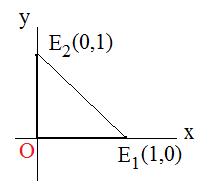 Let E1 and E2 denote the special points: E1(1,0), E2(0,1).
These points and the origin are vertices of a special triangle OE1E2.
Let E1 and E2 denote the special points: E1(1,0), E2(0,1).
These points and the origin are vertices of a special triangle OE1E2.
(a) it has a vertex at the origin O;
(b) the two sides OE1 and OE2 have lengths equal to 1 (so the triangle is isosceles);
(c) it is a right triangle because two sides lie along the perpendicular x-axis and the y-axis:
(angle E1OE2 = 90°);
(d) the angle E1OE2 is measured in a positive (counter-clockwise direction): OE1 is the initial side of the angle and OE2 is the terminal side. Notice that the label OE1E2 gives the triangle a positive (counterclockwise) orientation.
For a discussion on orientation click here.
Notation1: Linear transformation L preserves distance if and only if distance between images L(P) and L(Q) is the same as the distance between any points P and Q.
Notation2: For any pair of points (x1, y1) and (x2, y2),
|L(x1, y1) -- L(x2, y2)| = |(x1, y1) -- (x2, y2)|.
The identity transformation I preserves distance because it leaves everything fixed and unchanged. More specifically, I(P) = P and I(Q) = Q, so the distance between I(P) and I(Q) is the same as the distance between P and Q trivially.
The linear transformation L that interchanages coordinates L(x,y) = (y,x) preserves distance:
( distance between L(x1,y1) and L(x2,y2) ) squared =
|L(x1,y1) -- L(x2,y2)|2 =
|(y1, x1) -- (y2, x2)|2 =
... [chain of equalities]... =
|(x1, y1) -- (x2, y2)|2 =
(distance beetween (x1,y1) and (x2,y2) squared .
Click here to see the complete chain of equalities.
Notation 1: L preserves distance if and only if |L(p)| = |p| for every position vector p.
Notation 2: L preserves distance if and only if |L(x,y)| = |(x,y)| for every point (x,y).
Let P be any point. By the assumption, the distance between L(O) and L(P) is equal to the distance between O and P. Therefore
|OP'| = |OP| where P' = L(P). Therefore, L preserves lengths of position vectors.
Let Q and R be any points, Q' = L(Q) and R' = L(R) their images, with position vectors q, r, q', r' locating them. Let p = r -- q.Then
distance between L(Q) and L(R) squared =
The red == in the above chain of equalities is supported by the assumption.
Segments L(O), L(1,0), and L(O), L(0,1) and L(1,0), L(0,1) are congruent respectively to segments O, (1,0), and O, (0,1) and (1,0), (0,1). This fact makes the triangles congruent (sss).
This part of the proof uses the special orthonormal vectors i and j. According to [2.16] it will suffice to show that L preserves norms of position vectors,, that is |L(x,y)| = |(x,y)|. As usual it is easier to work with the squares of the norms. Recall that the square of a norm is equal to the inner product of what is between the norm symbols, with itself. The red == in the following chain of equalities is supported by the assumption.
By [2.17] and the assumption, the lintr preserves distance. Then it caries sides (segments) of any triangle onto congruent images of those sides (congruent segments), which could be sides of triangles.
Section 3: Geometric actions of some linear transformations on the plane
[3.0]In this section some geometric actions can be done by linear transformations. To prove this five steps are executed:
(i) An intuitive geometric description and/or definition of the action is given.
(ii) The action carries the special points (1,0) and (0,1) onto images, whose coordinates are calculated;
(iii) From the transposes of the images of the special points, form a matrix which will become the associated matrix of the linear transformation L in the next step.
(iv) From those images a linear transformation L is created: L(x,y) = x(image of (1,0)) + y(image of (0,1));
(v) Show that what the linear transformation L does, is the same as what the action in step (1) does.
Often between steps (i) and (ii) some obvious results of the statement in (i) are listed.
[3.1] Action: Reflection through the origin
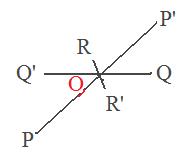 For any point not on the origin there is a line through that point and the origin. Push the point through the origin. On the other side of the origin go and stop when the image point will be the same distance from the origin as the original point.
For any point not on the origin there is a line through that point and the origin. Push the point through the origin. On the other side of the origin go and stop when the image point will be the same distance from the origin as the original point.
Notation: if P' is the image obtained by reflecting a point P through the origin, then O is the mid point of segment PP'.
(i) Vectors OP' = -- OP
(ii) Only the origin is carried back onto itself (left fixed); for all other points, P' and P are distinct
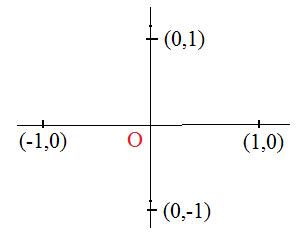
(i) the images of (1,0) and (0,1) are (-1,0) and (0,-1) respectively;
(ii) the special triangle has vertices O, (1,0), (0,1). Its image has vertices
O, (-1,0), (0,-1);
(c) the orientation of the image triangle is positive (counter-clockwise).
and the segment joining (0,1) and (0,-1).
The following matrix is formed from the transposes of these images:

To prove that L is the reflection through the origin, see where the mid point of (x,y) and L(x,y) lies.
(x,y) + L(x,y) = (x,y) + (-x,y) = (x + (-x), y + (-y)) = (0,0). Therefore (1/2) [(x,y) + (-x,y)] = (0.0). Hence origin O is the mid point of the segment joining (x,y) and L(x,y).
----------
[3.2] Action: Similitude, a uniform expansion outward from or a uniform contraction toward the origin
Consider a magnifying glass aimed at the origin. As the glass is lifted up, everything expands about the origin, but the origin stays fixed. A point P different from the origin is pushed outward on a straight line to a point P' so that O,P,P' are colllinear. A point Q is pushed outward on a straight line to a point Q' so that O,Q,Q' are collinear.
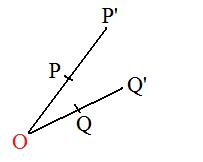 hspace=1000
Suppose the magnification pushes P and Q to new points P' and Q' twice as far from the origin, so that
hspace=1000
Suppose the magnification pushes P and Q to new points P' and Q' twice as far from the origin, so that
(i) if λ > 1, then image P' is further from the origin than P. This similitude is a niform dilation of the plane about the origin;
(ii) if λ = 1, then P'=P and the image of any point coincides with tht point. The similitude is the identity function on the plane, and no dilation nor contraction occurs;
(iii) if λ < 1 (but λ > 0) then image P' is closer to the origin than P. This similitude is a uniform contraction of the plane about the origin;
(i) if one similitude is followed by another the result is a similitude whose coefficient is the product of the two similitudes of the component similitudes;
(ii) the identity function is a similitude with coefficient 1;
(iii) the inverse of a similitude is a similitude whose coefficient is the inverse of the first similitude.
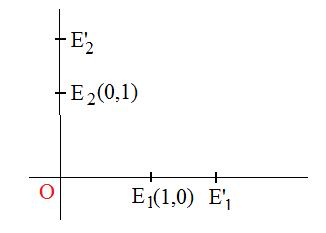

Notation: If P' and Q' are images of points P and Q respectively, then segment P'Q' is parallel to segment PQ.
There is a simple geometric proof of [3.2e] using the similarity of triangles P'OQ' and POQ.
Notation: If points A', B', C' are images of points A, B, C then angle A'B'C' is congruent to angle ABC.
Some of the trigonometric functions are used extensively below. The reader may wish to review some trigonometry. Click here to go to the review.
[3.3] Action: Orthogonal reflection of the entire plane about a line through the origin
Given a flat sheet of blank paper there are four ways under consideration to fold it. The folds are indicated by red lines.

 Figure Fig 1a shows a right triangle ABC drawn on the right half of a piece of paper. Suppose ink for the triangle has not dried. The paper will be folded along the vertical line which divides the paper into two halves. As a result the ink on the right triangle touches the left half of the paper and leaves a copy of a right triangle there. If the paper is unfolded and made flat again then there are two right triangles. (Fig 1b) The triangle A'B'C' on the left is a reflection of the triangle on the right about the vertical line where the paper had been folded.
Figure Fig 1a shows a right triangle ABC drawn on the right half of a piece of paper. Suppose ink for the triangle has not dried. The paper will be folded along the vertical line which divides the paper into two halves. As a result the ink on the right triangle touches the left half of the paper and leaves a copy of a right triangle there. If the paper is unfolded and made flat again then there are two right triangles. (Fig 1b) The triangle A'B'C' on the left is a reflection of the triangle on the right about the vertical line where the paper had been folded.
(a) the copy on the left side of the paper is congruent to the original triangle on the right side;
(b) the copy has an orientation opposite to the orientation of the original triangle on the right side.
The vertices of the original triangle on the right side are labeled A,B,C in a counter-clockwise direction. But the labels on the copy A',B',C' are given in a clockwise direction. The process of reflecting the original triangle about the vertical line makes a congruent figure but reverses orientation.
 This time a not-yet-dried parallelogram ABDC is located in the upper half of another paper, and a horizontal line is drawn below it. The paper is folded along the horizontal line to produce a copy of the parallelogram A'B'C'D' in the lower half of the paper. (Fig 2). A reflection about the horizontal line has occurred. The parallelograms are congruent but have opposite orientation.
This time a not-yet-dried parallelogram ABDC is located in the upper half of another paper, and a horizontal line is drawn below it. The paper is folded along the horizontal line to produce a copy of the parallelogram A'B'C'D' in the lower half of the paper. (Fig 2). A reflection about the horizontal line has occurred. The parallelograms are congruent but have opposite orientation.
geometric definition L(P) = P' where the y-axis is the perpendicular bisector of segment PP' or P=P' if point P is on the y-axis.
algebraic definition L(x,y) = (-x,y).
geometric definition L(P) = P' where the x-axis is the perpendicular bisector of segment PP' or P=P' if point P is on the x-axis.
algebraic definition L(x,y) = (x,-y).
Of course, this lintr is different from the lintr that is a reflection about the y-axis described in [3.1a]..

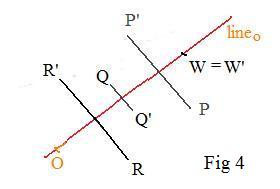
The geometric description of an orthogonal reflection about any line is the same outside the coordinate plane. In the adjacent figure a slant lineo is used. It is called the axis of the reflection. Points P,Q,R are reflected about lineo onto points P',Q',R'. Again the axis is the perpendicular bisector of segments PP', QQ', RR'. Point W is on the axis, so W' = W. If a lintr is to be involved, then the axis must pass through the origin O. Incidentally, the word "orthogonal" means perpendicular. There are reflections, not discussed in these sections, of "slant reflections" in which the segments PP'.QQ', RR' are not perpendicular to the axis. Their mid points do lie on the axis, and all the segments are parallel. Only orthogonal reflections are discussed here. Sometimes the word "orthogonal" is omitted, but understood.
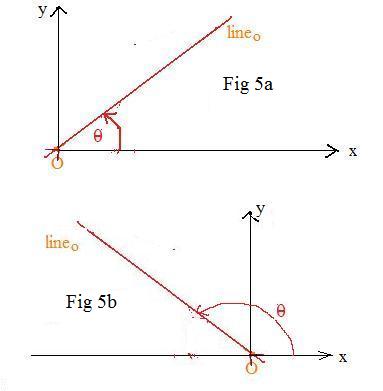 It is obvious that the position and location of the axis completely determines the reflection. The axis may be placed as a lineo in the coordinate plane so that it passes through the origin O. Let θ be the inclination angle as shown. If θ is between 0° and 90° then lineo slants from lower left to upper right (Fig 4a). If lineo is between 90° and 180° then lineo slants from lower right to upper left (Fig 4b). There is no need to consider angles between 180° and 360° because θ and θ - 180° determine the same lineo.
It is obvious that the position and location of the axis completely determines the reflection. The axis may be placed as a lineo in the coordinate plane so that it passes through the origin O. Let θ be the inclination angle as shown. If θ is between 0° and 90° then lineo slants from lower left to upper right (Fig 4a). If lineo is between 90° and 180° then lineo slants from lower right to upper left (Fig 4b). There is no need to consider angles between 180° and 360° because θ and θ - 180° determine the same lineo.
geometric definition If P' is the reflected image of any point P then the line is the perpendicular bisector of segment PP', or P=P' if point P is on the line (Fig 4).
algebraic definition The matrix associated with the orthogonal reflection about a line through the origin and making an inclination angle θ with the positive x-axis is

If θ = 0° or θ = 180° then lineo is the x-axis. The associated matrix (6) becomes the second matrix in (3) above.
If θ = 45° then lineo bisects the angle between the positive x-axis and the positive y-axis. The reader can replace θ in the formula for L in [3.1e] by 45° (dont forget to double this angle to 90°) and obtain: L(x,y) = (y,x). Therefore L interchanges the coordinates. What is the matrix associated with L ?
[3.4] Action: Rotation of the entire plane about the origin and through a given angle
Throughout this chapter the following are true:
(i) All rotations are about the origin O.
(ii) All rotations are actually functions that carry the plane into (or onto) itself.
(iii) Two rotation functions are equivalent if they carry each point P onto the same point P'.
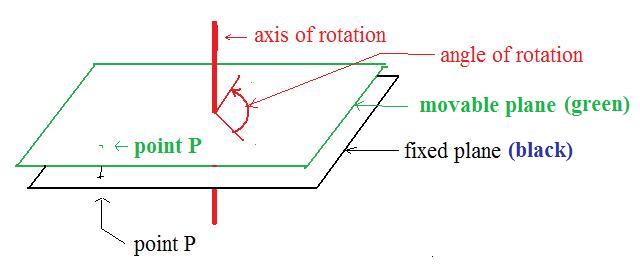 [3.4a] (Intuitive geometric description 1) Keep in mind that the rotation function on the plane carries points onto points in a definite manner. The plane does not move, so it will be called the fixed plane. A second plane is invented to carry out the motion of rotation. It is called the plane(See adjacent figure.) It lies above the fixed plane. There is a hole just above the origin in the other fixed plane. An axis is created perpendicular to the fixed plane and runs through the hole.
[3.4a] (Intuitive geometric description 1) Keep in mind that the rotation function on the plane carries points onto points in a definite manner. The plane does not move, so it will be called the fixed plane. A second plane is invented to carry out the motion of rotation. It is called the plane(See adjacent figure.) It lies above the fixed plane. There is a hole just above the origin in the other fixed plane. An axis is created perpendicular to the fixed plane and runs through the hole.
The phrase "rotation function on a plane" is less common that the phrase "rotation of the plane". The reader may mentally attached the word "function" to the word "rotation" whenever it occurs alone in this section.

[3.4b] (Intuitive geometric description 2) With one end point fixed on the origin O swing segment origin OP around in a circular motion through angle θ and stop. Then the segment origin OP' is formed. The point P' is the rotated image of point P. If θ is positive, the the motion is counter-clockwise (Fig 1a). If θ is negative then the motion is clockwise (Fig 1b).
(i) The angle completely determines the rotation.
(ii) Any point and its rotated image are the same distance from the origin.
(iii) If θ = 0, there is no motion. Then P' = P. The identity function I is a rotation through an angle of zero.
(iv) The rotation of any point about the origin through an angle of θ is equivalent to a rotation of that same point through an angle of θ - 360°.
(v) The rotation through any number of revolutions, positive or negative, carries each point back onto itself.
(vi) A rotation through an angle -180° is equivalent to a rotation through an angle of 180°.
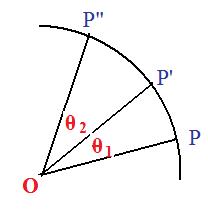
Notation: If θ1 and θ2 are the angles of the two rotations, then their combined action (composition) is a rotation with an angle of θ1 + θ2.
Since θ + -θ = 0, every rotation has an inverse. Simply rotate the same amount but in the opposite direction.
From the transpose of coordinates of image points form the matrix

Notation: x' = x cos θ + y sin θ and y' = -x sin θ + y cos θ.
[3.5] Action: Orthogonal projection of the entire plane onto a line through the origin
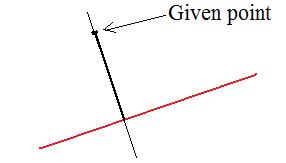 One of the important constructions in plane geometry is to construct a line through a given point and perpendicular to a given line. (Only a compass and straight edge can be used.)
One of the important constructions in plane geometry is to construct a line through a given point and perpendicular to a given line. (Only a compass and straight edge can be used.)
(ii) The image of a line or line segment perpendicular to the given line is a point.
(iii) Parallel line segments not perpendicular to the given line are projected onto congruent segments inside the given line.
(iv) A projection carries subsets of 2 dimensions (have langth and width) onto subsets of lesser dimension (as usbsets of the given line).
(v) There is no inverse action to undo the action of a projection.
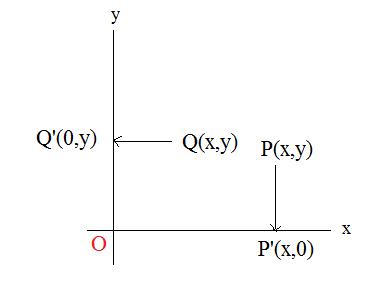 Two simple orthogonal projects occur in the coordinate plane if the given lines are the axes. In Fig 3 the arbitrary point P(x,y) is orthogonally projected onto the x-axis, and the arbitrary point Q(x,y) is orthogonally projected onto the y-axis. It is not difficult to determine the image points, namely P'(x,0) and Q'(0,y). (The second coordinate of every point on the x-axis must be 0. The first coordinate of every point on the y-axis must be 0. The projections are vertical and horizontal respectively.)
Two simple orthogonal projects occur in the coordinate plane if the given lines are the axes. In Fig 3 the arbitrary point P(x,y) is orthogonally projected onto the x-axis, and the arbitrary point Q(x,y) is orthogonally projected onto the y-axis. It is not difficult to determine the image points, namely P'(x,0) and Q'(0,y). (The second coordinate of every point on the x-axis must be 0. The first coordinate of every point on the y-axis must be 0. The projections are vertical and horizontal respectively.)

Notation: (onto the x-axis) x' = x and y' = 0; (onto the y-axis) x' = 0 and y' = y.
[3.5e] (Projection of the special points) The orthogonal projection of points (1,0) and (0,1) onto a line through the origin and with inclination angle θ (made with the positive x-axis) are the points

[3.5f] (General formula for projection) The linear ttransformation L defined by
Notation: x' = x cos2θ + y sin θ cos θ and y' = x sin θ cos θ + y sin2θ
A projection onto a line is singular because it has no inverse. There is no linear transformation that will undo what a projection has done. This is confirmed by the determinant of (4) which is zero. However, the matrix in (4) has rank 1, making projections onto lines having rank 1. See [2.7] above.
Section 5: Linear transformations that preserve distance
In geometry it may be said that two figures are congruent if they can be made to coincide. Intuitively speaking, an action is taken, namely, one figure is moved without distortion over to the other so that they coincide. In some situatons, a linear transformation may do the moving. Most such movements require the use of translations which are not a linear transformations. (They carry figures without distortion but they do not carry the origin back onto itself.) Translations are discussed in the next chapter.
Notation: if P and Q are any points then the distance between P and Q = the distance between L(P) and L(Q).
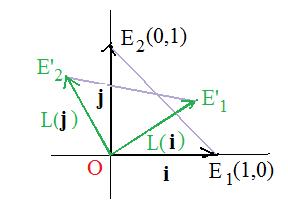
Notation: L preserves distance if and only if L(i) and L(j) are orthonormal position vectors:
Then using inner products
|L(p)|2
=
(L(p)) * (L(p))
=
(xL(1,0) + yL(0,1)) * (xL(1,0) + yL(0,1))
=
x2L(1,0)*L(1,0) + 2xyL(1,0)*L(0,1) + y2L(0,1)*L(0,1)
=
x2|L(1,0)|2 + 2xy 0 + y2|L(0,1)|2
=
x2 + y2
=
|p|2 &nbs0p; (by the distance formula)
===============================================================
------------------------------------------------

(a) Definition: a function L such that the origin O is always the mid point of the segment joining any point to its image.
Notation: O is the mid point of segment joining P to P' = L(P).
(b) Position vectors: L(p) = --p, p' = --p
(c) Coordinates: L(x,y) = (--x,--y), x' = --x, y' = --y
(d) Distance: Preserved
(e) Orientation: Preserved
(f) Matrix: As shown above
(g) Special Functional Equations: (Involution) L*L = I, L-1 = L
(h) Sets left fixed setwise but not pointwise: All lines through the origin, all circles with centers at the origin, any subset symmetric about the origin
(i) Points left fixed: origin
[3.2] Action: Rotation function on the entire plane with a given angle at the origin
 Keep in mind that the rotation function on the plane carries points onto points in a definite manner. The plane does not move. Therefore a second plane is invented to carry out the motion of rotation.(See adjacent figure.) It lies above the fixed plane. There is a hole just above the origin in the other plane. Suppose this plane is empty. An axis is created perpendicular to the fixed plane and runs through the hole.
Keep in mind that the rotation function on the plane carries points onto points in a definite manner. The plane does not move. Therefore a second plane is invented to carry out the motion of rotation.(See adjacent figure.) It lies above the fixed plane. There is a hole just above the origin in the other plane. Suppose this plane is empty. An axis is created perpendicular to the fixed plane and runs through the hole.
The phrase "rotation function on a plane" is less common that the phrase "rotation of the plane". In the latter situation the black plane is rotated and the green plane that contains the copies of all points is left fix. However, the black plane is rotated in the opposite direction that was suggested in movement of the green plane described above. After the black plane is rotated, the green point P is copied back down onto the black plane, locating the image point P'. This method of rotation is used only in a few examples. The rotation function, also called rotation, is described in this section. (The reader may mentally attached the word "function" to the word "rotation" whenever it occurs in this section.) The phrase "about the origin" means that the origin is left fixed by the rotation (function).
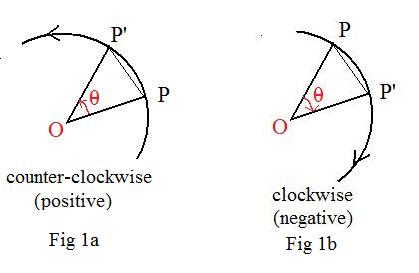 The vertex of the angle is always at the origin, which is left fixed. Any other point and its image form an isosceles triangle with the angle as sides. The orientation origin-point-image of the triangle is the same as the orientation of the given angle: both are counter-clockwise or both are clockwise.
The vertex of the angle is always at the origin, which is left fixed. Any other point and its image form an isosceles triangle with the angle as sides. The orientation origin-point-image of the triangle is the same as the orientation of the given angle: both are counter-clockwise or both are clockwise.
Rotating the plane about the origin through angles equal to any number of complete revolutions, positive or negative also produces the identity function.
A similar argument exists for θ = 1 rev (360°), 2 ref (720°), ..., - 1 rev, - 2 rev,...
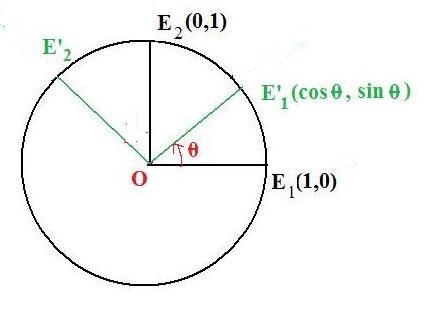 Next is the derivation of the matrix for a rotation L about the origin through an angle θ.
Next is the derivation of the matrix for a rotation L about the origin through an angle θ.

y' = -x sin θ + y cos θ
[3.3] Action: Orthogonal reflection of the entire plane through a line that passes through the origin.
The line is called its axis of reflection.

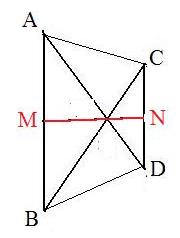 If a mirror is placed vertically on the axis of reflection, then images of things are seen in the mirror. The image of a line segment is a line segment. The line segment and its image seem to have the same length. A proof that the orthogonal reflection about a line preserves distance is based on the fact that
If a mirror is placed vertically on the axis of reflection, then images of things are seen in the mirror. The image of a line segment is a line segment. The line segment and its image seem to have the same length. A proof that the orthogonal reflection about a line preserves distance is based on the fact that
 Let P and Q be any pair of points. Let P' = L(P) and Q' = L(Q) be their images under an orthogonal reflection L about a line MN. Then MN is the perpendicular bisector of the parallel lines PP' and QQ'. There are two cases. Points P and Q are on the same side of MN (Fig 1a) and P and Q are on opposite sides of MN (Fig 1b). Both cases satisfy the conditions of the above theorem (*). The darkened sides PQ and P'Q' in Fig 1a have the same length. The darkened diagonals PQ and P'Q' in Fig 1b have the same length. Therefore, orthogonal reflection L preserves distance.
Let P and Q be any pair of points. Let P' = L(P) and Q' = L(Q) be their images under an orthogonal reflection L about a line MN. Then MN is the perpendicular bisector of the parallel lines PP' and QQ'. There are two cases. Points P and Q are on the same side of MN (Fig 1a) and P and Q are on opposite sides of MN (Fig 1b). Both cases satisfy the conditions of the above theorem (*). The darkened sides PQ and P'Q' in Fig 1a have the same length. The darkened diagonals PQ and P'Q' in Fig 1b have the same length. Therefore, orthogonal reflection L preserves distance.
 It is convenient to place the reflection in the familiar x,y-coordinate system. Let L be the orthogonal reflection about a lineo through the origin making an inclination angle θ with the positive x axis. The angle is measured positively, meaning counterclockwise. That angle determines completely the location of the lineo.
It is convenient to place the reflection in the familiar x,y-coordinate system. Let L be the orthogonal reflection about a lineo through the origin making an inclination angle θ with the positive x axis. The angle is measured positively, meaning counterclockwise. That angle determines completely the location of the lineo.
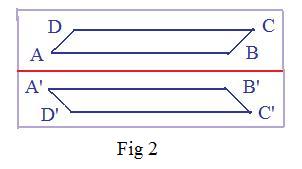
Case 3: Orthogonal reflection L about the x-axis. Then lineo coincides with the horizontal x-axis and θ = 0°. Then L carries E1 onto itself, so E'1 = E1. However E2 is reflected downward on the y-axis. Therefore the coordinates of the reflected points are
![]()
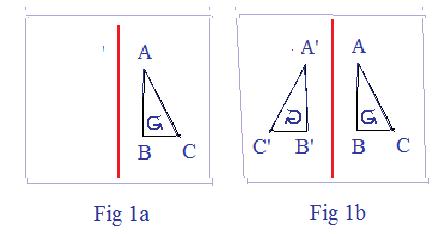 Case 4: orthogonal reflection L about the y-axis. Then lineo coincides with the vertical y-axis and θ = 90°. Then L carries E2 onto itself, so E'2 = E2. However E1 is reflected left on the x-axis. Therefore the coordinates of the reflected points are
Case 4: orthogonal reflection L about the y-axis. Then lineo coincides with the vertical y-axis and θ = 90°. Then L carries E2 onto itself, so E'2 = E2. However E1 is reflected left on the x-axis. Therefore the coordinates of the reflected points are
![]()
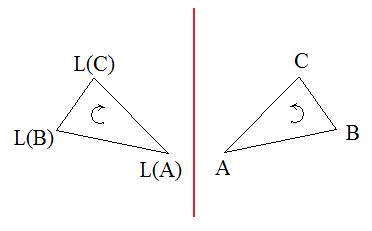 The adjacent figure shows that a reflection about a line reverses orientation. In that figure the labels L(A), L(B), L(C) and the labels A, B, C are in opposite order. It is not a coincidence that the determinant of the above matrix (8) associated with the reflection is negative (more exactly -1).
The adjacent figure shows that a reflection about a line reverses orientation. In that figure the labels L(A), L(B), L(C) and the labels A, B, C are in opposite order. It is not a coincidence that the determinant of the above matrix (8) associated with the reflection is negative (more exactly -1).
If the line is the edge view of a vertical mirror, the image in the mirror of triangle ABC would be triangle L(A)L(B)L(C) with its reverse orientation. Hence the name "reflection" for the function L.
Section 4: Distance preserving
Section 2: Linear transformations that preserve distance
[2.1] (Distance preserving functions) A function on the plane (or space) preserves distance if and only if the distance between every pair of points is equal to the distance between their images.
Notation:
F preserves distance if and only if
 What distance preserving functions do with the origin is important. It is possible to produce two simple congruent figures, but no distance preserving linear tranformation can carry the first figure onto the second. On the horizontal x-axis, the segment with end points (0,0) and (1,0) is congruent to the segment with end points (2,0) and (3,0). Any function that carries the first segment into the second must carry the origin onto some point in the second segment. But by [1.1] this is enough to prove that no linear transformation may carry the first segment onto the second. (The situation will be resolved in the next chapter with the introduction of a new kind of geometric function that is affine.)
What distance preserving functions do with the origin is important. It is possible to produce two simple congruent figures, but no distance preserving linear tranformation can carry the first figure onto the second. On the horizontal x-axis, the segment with end points (0,0) and (1,0) is congruent to the segment with end points (2,0) and (3,0). Any function that carries the first segment into the second must carry the origin onto some point in the second segment. But by [1.1] this is enough to prove that no linear transformation may carry the first segment onto the second. (The situation will be resolved in the next chapter with the introduction of a new kind of geometric function that is affine.)
Notation: L preserves norm if and only if |L(p)| = |p| for any position vector p.
=
(x sin θ + y cos θ)2 + ( -x cos θ + y sin θ)2
=
x2 sin2θ + 2xy sin θ cos θ + y cos2θ +
x2 cos2θ - 2xy sin θ cos θ + y sin2θ
=
x2 (sin2θ + cos2θ) +
x2 (cos2θ + sin2θ)
=
x2 + y2
=
|(x,y)|2
Therefore, |L(x,y)| = |(x,y)| which shows that L preserves norms.
Notation: L preserves distance if and only if |L(p)| = |p| for all position vectors p.
Conversely, suppose L preserves norms. Let Q and R be any points. Let p = q -- r.
Notation: if L preserves distance and if θ is the angle between line1 and line
Notation: L preserves distance if and only if L(p)*L(q) = p*q for all position vectors p and q.
Section 5: Fixed points
Notation: P is a fixed point of a linear transformation L if and only if L(P) = P.